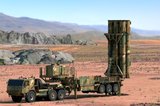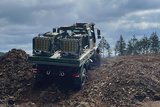Lithuania begins NASAMS testing
The Lithuanian Air Force has commenced testing of the NASAMS medium-range air defence system, the Lithuanian Ministry of Defence announced on 3 October.
Lithuania signed the contract with Kongsberg to acquire NASAMS in October 2017. The €110 million contract includes two air defence batteries and a logistical maintenance package, as well as training for operators and maintenance personnel.
The testing will see components of the weapon system - missile launchers, radars, electro-optical sensors, components of integration with the RBS 70 short-range air defence systems, communication and control components, and vehicles - tested at the production facility, then put to field trials in Lithuania. The trials will assess technical and tactical conformity of NASAMS components to the determined weaponry specification.
The testing will run until February 2020, with the system planned to be officially delivered by the end of 2020.
The system procured by Lithuania includes ex-Norwegian armed forces launchers that have been upgraded to manufacturer parameters. The systems procured from Norway use US-made AMRAAM aircraft defence missiles capable of destroying aircraft and missiles of an adversary several tens of kilometres away.
The equipment will be fully integrated into a system capable of completing air defence tasks: monitor and control air space, issue warning to ground-based units about air threats, and to destroy targets if necessary.
Related Equipment in Defence Insight
More from Land Warfare
-
![Battlefield mobility, made in the UK]()
Battlefield mobility, made in the UK
How does Britain ensure that we can preserve the lives of our soldiers and allies – now and in the future – with homegrown innovation and resilient domestic manufacturing? At Pearson Engineering, we are proud to be a central part of the answer to this increasingly important question.
-
![First capability of Israel’s Iron Beam laser to be delivered by the end of December]()
First capability of Israel’s Iron Beam laser to be delivered by the end of December
Iron Beam is a family of high-energy laser weapon systems currently in development by Rafael Advanced Defense Systems and is designed to provide a low-cost kinetic effect against aerial threats at short distances.
-
![Hanwha awarded $482 million in major step for South Korea’s missile defence programme]()
Hanwha awarded $482 million in major step for South Korea’s missile defence programme
The deal to produce and supply launchers and missiles to South Korea follows a contract placed with Hanwha Systems last month for the manufacture of multi-function radars.
-
![Strengthening Baltic defence capabilities]()
Strengthening Baltic defence capabilities
How Latvia is bolstering its territorial defences, industrial capacity and international cooperation with Dynamit Nobel Defence’s SKORPION2 Remote Mining System.
-
![Land forces review: British Army vehicle programme stalls and company results land]()
Land forces review: British Army vehicle programme stalls and company results land
In the first monthly review of land forces stories, the Shephard team looks back to evaluate the major news events that have impacted the sector. The UK’s Land Mobility Programme was notable but another setback occurred when a market industry day was scrapped.























